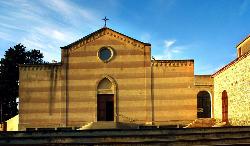Skip navigation bar and go to contents
Vivere la campagna
 Agricoltura
Agricoltura
 Ambiente
Ambiente
 Bilancio e Patrimonio
Bilancio e Patrimonio
 Consigliera di Parità
Consigliera di Parità
 Cultura
Cultura
 Formazione Professionale
Formazione Professionale
 Immigrazione/Emigrazione
Immigrazione/Emigrazione
 Innovazione Tecnologica
Innovazione Tecnologica
 Lavori pubblici e Viabilità
Lavori pubblici e Viabilità
 Lavoro
Lavoro
 Personale
Personale
 Pianificazione Territoriale
Pianificazione Territoriale
 Politiche giovanili
Politiche giovanili
 Politiche Sociali
Politiche Sociali
 Protezione civile
Protezione civile
 Pubblica Istruzione
Pubblica Istruzione
 Sport
Sport
 SUAP
SUAP
 Trasporti
Trasporti
 Turismo
Turismo
 URP
URP

The church of Sant’Anna, whose construction dates back to the 16th century at least, has been the seat of the Brotherhood of Carmine since 1726; it underwent different restoration works in the following centuries. It hosts the statue of the Virgin of Carmine as well as a simulacrum of Sant’Anna, whose datation is quite difficult due to a later re-painting (yet the statue is no doubt most ancient). The parish church of Nostra Signora delle Grazie was rebuilt between 1781 and 1786 upon a pre-existing church, which has left a Gothic bell tower, for the most part modified and superelevated to suit the Baroque style of the whole complex. Inside is the retable of Sant’Anna, dated 1576 and attributed to Antioco Mainas, illustrating the Crucifixion in its central part. The church of San Lorenzo, built at the beginning of the 14th century, stands inside the old borough. It underwent some changes throughout the centuries, as confirmed by works of the 17th century, when the roof, the chapels of San Lorenzo and of the Virgin of Itria were rebuilt; also, a porch was added onto the façade. This latter is surmounted by a sail-shaped bell tower, with two lights and two bells (one of them is more ancient than the other). This led to suppose that the edifice had been built upon a pre-existing church, whose bell is the only surviving item. The church of San Martino Vescovo was raised in the 13th century in Romanesque style; it underwent several modifications in time. It has got a simple plan, with single nave, hemi-circular apse and trussed roof. Little was left of the original furniture, as it partly went lost and transferred in the parish church of the village. The church of San Pietro rises in the centre of the small town. Built in Romanesque style, it was consecrated in 1377, as confirmed by an epigraph in Sardinian language kept inside the edifice. It also guards a gilt wooden altar dating from the early 1700, a few 18th-century canvases and a wooden simulacrum of Saint Peter, of the 14th century. In the past, the church hosted the Retable of Sant’Eligio, a most valuable work of early 1500, attributed to an unknown author, conventionally called ‘the Master of Sanluri’; the work is now kept at the National Picture Gallery of Cagliari.